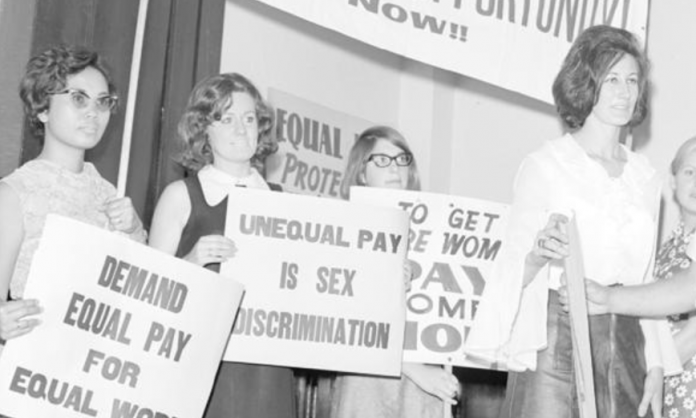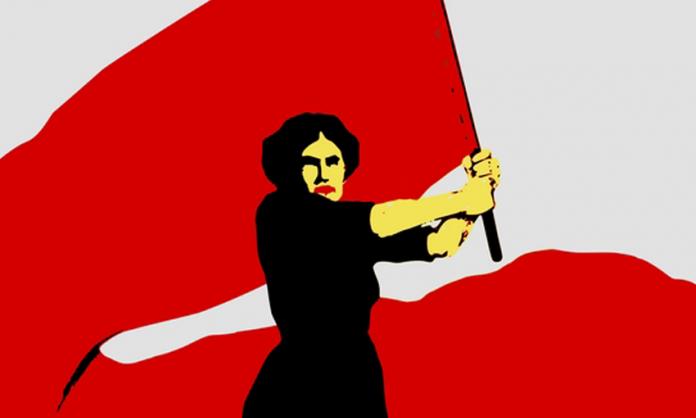They’re not your quintessential working-class militants: insurance clerks in city office blocks, processing insurance claims in nicely ironed business shirts. It’s difficult for us to imagine 3,000 of them marching out of work and pouring into the streets of Melbourne, on strike to demand equal pay for women. But the 1970s were radical years. Historian Geoff Gleghorn quotes one insurance industry employer reflecting on the young people he hired back then: “They’d come in and give me a really hard time. They’d ask hard questions and they’d question the system, and they’d ask me whether it was reasonable for them to work for capitalist bastards like me”.
Insurance workers, 50 percent of whom were women, fought for and ultimately won equal pay between 1973 and 1975. In so doing, they took their place alongside militant workers across Australia who, over the course of the 1960s and 1970s, forced employers, governments and courts to accede to this important demand.
The union representing insurance workers had lent verbal support to equal pay since 1927. But the changes in the workforce, as well as the more combative political climate in the late 1960s and 1970s, created the potential for the union to turn this sentiment into action. Initially made up of a small number of well-heeled, middle class people (mostly men), the insurance workforce expanded dramatically during the long boom following WWII. These new workers were mostly low paid, and many were women.
By the 1970s, a number of militant unions, like the meatworkers and liquor trades, had been on strike for equal pay, which helped create an atmosphere in which even industrially conservative unions, like the Australian Insurance Staffs’ Federation (renamed Australian Insurance Employees’ Union in 1976), could be propelled into action.
Prior to 1975, there was a yawning chasm between male and female wages in the insurance industry. Two completely different pay scales existed. “You’d have these 50-year-old women training some fresh-faced 19-year-old boy, who’d then be slotted into a pay scale above [the woman]”, Diane Fieldes, a historian of the Australian Insurance Staffs’ Federation’s equal pay campaign, tells me. Sexist humiliations extended beyond the issue of pay. “Women, regardless of age, were ubiquitously regarded as ‘girls’ by management”, says Fieldes, “which was a common source of annoyance to them”.
Sexism was not confined to the management. Although it later became an outlet for arguments in favour of equal pay, for decades the pages of the AISF’s journal Premium had reflected a sexist and patronising attitude to women workers. In his history of the insurance unions, Gleghorn describes the January-February 1959 edition carrying a full length photo of a federation member winning a “Beach Girl” contest in Queensland, printed opposite the new minimum award rates in the industry—₤795 per year for a 21-year-old male, with the comparable rate of ₤630 for women.
Despite this, Fieldes dismisses what she calls “the common-sense image that it must have just been women who wanted to fight for equal pay”. Women were certainly more likely to support and lead the equal pay campaign, but not all did. Some held internalised sexist views about women’s capacities, while a small number of others were in positions of authority or seniority and were accordingly disinclined to rock the boat. Some actively opposed equal pay. One of the staunchest defenders of the gender pay gap was Jan Martin, a female personnel manager who often appeared for the bosses at tribunal hearings.
For men or women aligned with the boss, this made sense. The pay gap not only made female labour cheaper but also made it easier for the employers to hold down male wages by threatening to replace men with cheaper female labour and dividing the workforce along sexist lines. They hoped that men could be enlisted to oppose equal pay and keep women’s wages woefully low.
But plenty of men, particularly militant unionists, could see through this. The trailblazing unions that led the fight for equal pay, like the metalworkers and meatworkers, were majority male. A leading rank-and-file activist in the federation’s equal pay campaign was a man, Phil Griffiths, also a committed socialist.
Fieldes describes scenes of activists like Griffiths admonishing other men at union meetings for opposing equal pay. Griffiths recalled in interviews with Fieldes that “huge numbers of women were drawn into the union because it was fighting for equal pay”. But at all the rallies and union mass meetings, there was nevertheless still a “moderate majority of men”.
Importantly, leading activists didn’t want the campaign to involve or appeal only to women. Many women were furious when the union leadership tried to hold “women only” meetings about equal pay. They crossed out the offending lines on union posters, demanding that men attend and take the issue seriously.
The judiciary and the Labor Party under Gough Whitlam are often credited with the equal pay victory. But as Fieldes points out, the first successful equal pay case, which granted “equal pay for equal work” occurred in 1969, at the end of 23 years of uninterrupted Liberal rule and before Whitlam was elected. The arbitration system and the government, says Fieldes, “fought tooth and nail all the way along; they only did what the bosses wanted until there was a sufficient level of struggle from our side to push them over the edge”. Mass strikes in 1969 pushed a conservative arbitration court to grant equal pay for the first time. But it was “equal pay in the narrowest possible sense, and deliberately so”, says Fieldes.
It was narrow because the ruling applied only to women doing the exact same jobs as men. This meant that by 1972 only 18 percent of women workers were able to achieve equal pay. In addition to many women simply not performing identical work, Fieldes points out that the decision prompted “an orgy of reclassification by bosses, turning what were exactly the same jobs into jobs with different names depending on whether men or women were doing them”. Subsequent rulings in the Arbitration Commission in 1972 and 1974 increased the scope of equal pay, but many workers still had to fight their bosses to have it implemented.
The decisions had little impact on the position of women insurance workers; they were no better off by 1973. As enthusiasm and militancy around the issue grew, the insurance bosses steadfastly refused to negotiate with the federation, and when they did, insisted on a complete reclassification of every job in the industry. Knowing that they would be affected by the rulings eventually, the bosses hoped to recuperate their losses by redefining jobs to maintain women’s lower wages. But insurance workers were having none of it.
Before taking on their bosses though, the workers first had to contend with their own officials. The union officials had never led a strike and preferred to hobnob with bosses in fruitless negotiations. They had a disdainful attitude to the rank and file, blaming members’ apathy for their inaction on equal pay. But as militants pointed out in the rank-and-file newsletter Miccy Finn, “the union has paid little more than lip service towards equal pay ... [and] have misinterpreted [as apathy] the good faith of women who believe that they can expect the union to lead any necessary campaign”.
In reality, what concerned officials was the lack of apathy, which was shaping up as a challenge to their conservative approach. Indeed, Ken McLeod, general secretary of the federation during 1973, worried members thought “that equal pay means the removal of all female rates of pay from the award” and could lead to “expectations which might well be impossible to realise”.
Fieldes describes how this situation was turned around. “The carrot of equal pay has been dangled in front of [members, but their wage stays the same. Which creates an opening for the militants to say ‘look at which unions are getting movement on this issue. It’s the ones who are going on strike’.”
Many of the militants Fieldes mentions were members of the Socialist Workers’ Action Group (SWAG), a precursor to Socialist Alternative. In 1972, they began distributing an underground newsletter, Clerk and Dagger, to thousands of office workers. Phil Griffiths, a 20-year-old clerk at the time, was the driving force of the newsletter, which later spawned the Militant Insurance Clerks group and its newsletter, Miccy Finn.
The chief aims of Clerk and Dagger were, according to historian of SWAG Tess Lee Ack, to “flush out union militants” and “establish rank and file groups” in the white-collar unions. Articles in the paper attacked sexist workplace discrimination, campaigned for equal pay and argued for militant industrial action to fight for higher wages. They criticised the conservative approach of the union leaders and encouraged rank and file activists to take action.
This tension was apparent at some of the women-only meetings called by the union in September 1973. At the largest meeting in Melbourne, young militants Marie O’Donnell and Sandra Fenn, among others, overturned the bureaucracy’s approach. They moved a hostile amendment that, according to Fieldes, “objected to the meeting being described as ‘this meeting of representatives of the federation's female membership’ and deleted the reference to ‘female’. They added a call for the executive to prepare plans for industrial action and present them to the membership. Finally, they rejected the proposal for ‘similar meetings to this’ to be held throughout the campaign, calling instead for ‘stop-work meetings of the membership’”. Their amendment was carried.
The next month, October 1973, the insurance bosses’ peak body made an insulting equal pay offer that would have lowered the ceiling on women’s wages. The bosses were explicit that they intended to cut men’s wages. In their own words, “classification will allow a reduction in the cost of lower level jobs carried out by older males”.
The following day, between 2,000 and 3,000 insurance clerks held a demonstration outside the National Mutual building in Melbourne while the union and bosses met inside. They voted to stay out on strike for the rest of the afternoon. The feeling among activists like Griffiths was ecstatic. He recalled to Fieldes, “The sense of anger was tremendous ... I remember going back into the office, completely fired up, racing around the office saying ‘That’s it! We’re on strike. Come on, let’s get going’”.
The momentum of the campaign and intransigence of the employers compelled the union officials to propose a national strike for 14 December 1973. The federation’s federal executive still hoped that the mere threat of such a stoppage would force the bosses and the courts to grant equal pay. According to the officials, it wasn’t the strike and the militancy of the members that would win equal pay, but the threat of one, which would force the bosses into a negotiated settlement in court. Nonetheless, enthusiastic federation members voted overwhelmingly in favour of going on strike—for the first time in their history.
As the strike date approached, the federation’s leadership busied itself trying to settle the matter in the Arbitration Commission. Justice Elizabeth Evatt handed down a wage rate the day before the proposed strike, which differed little from the bosses’ insulting offer. It did not grant equal pay, but it removed the immediate threat of downward classification. The bureaucracy called off the strike at the last minute without consulting its members. This meant that insurance workers waited another two years for the commission to grant equal pay, and loopholes ensured some gender pay gap persisted.
The federation experienced unprecedented growth in these years, particularly at the height of the ferment in late 1973. The campaign changed the attitudes of men and women toward each other. After hundreds of hours spent fighting together (and losing pay) to win equality, it became harder for men to hold on to sexist prejudice. Gleghorn observed that “the achievement of equal pay, the union-wide heat it generated and a new attitude it created to women workers, was a million miles from [the] sexist jokes and equality on male terms of the earlier years of the Federation”. As a sign of the change, sexist cartoons and patronising recruitment ads aimed at women had completely disappeared from the pages of Premium by 1972.
The story of the insurance workers’ campaign demonstrates that even unions which seem passive, weak and unwilling to strike can be transformed under the right conditions. The actions of rank-and-file members was key: socialists and other militants played an important role in galvanising other workers to challenge the officials. They were willing to go out on a limb, wage arguments and challenge the official union line, without which the gains made by insurance workers in 1973 would have been nothing but a pipe dream.










